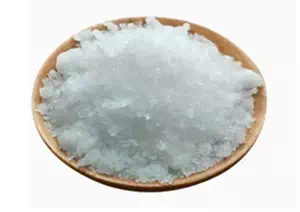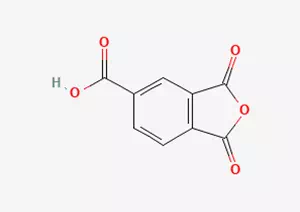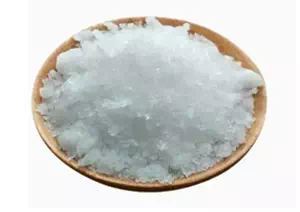All Categories



trimellitic anhydride CAS 552-30-7, trimellitic anhydride, CAS 552-30-7
Among the numerous substances in the field of chemical engineering, there is an important compound, whose full name is triphenyltrianhydride, and it is often abbreviated as partial anhydride in the industry. In terms of its precise chemical name, it is called 1,2, 4-phenyltricarboxylic anhydride.
CAS : 552-30-7
Formula : C9H4O5
Mol. wt. : 192.13
EINECS : 209-008-0
Chemical Name | Trimellitic Anhydride |
Other Name | 1,2,4-Benzeneticarboxylic anhydride |
CAS | 552-30-7 |
EINECS | 209-008-0 |
Type | Organic raw materials |
Molecular Formula | C9H4O5 |
Molecular Weight | 192.13 |
Melting point | 163-166 °C (lit.) |
Boiling point | 390 °C |
density | 1.54 |
vapor density | 6.6 (vs air) |
vapor pressure | <0.01 mm Hg ( 20 °C) |
refractive index | 1.4717 (estimate) |
Fp | 227 °C |
storage temp. | Store below +30°C. |
solubility | 24.4g/l (decomposition) |
form | Flakes |
color | White to off-white |
PH | 2 (21g/l, H2O, 20℃) |
explosive limit | 1-7%(V) |
Water Solubility | DECOMPOSES |
Sensitive | Moisture Sensitive |

Among the numerous substances in the field of chemical engineering, there is an important compound, whose full name is triphenyltrianhydride, and it is often abbreviated as partial anhydride in the industry. In terms of its precise chemical name, it is called 1,2, 4-phenyltricarboxylic anhydride. For the convenience of expression and memory, the abbreviation TMA is usually used to refer to it.
In terms of appearance, some anhydrides present a relatively regular form, specifically manifested as white blocky or granular solids. Analyzed at the microscopic molecular level, its molecular formula is clearly C9H4O5. Through professional calculation methods, its relative molecular mass can be determined to be 192.12. In terms of physical properties, it has a specific melting point and boiling point. The melting point is 168℃. When the temperature reaches this value, it will change from a solid state to a liquid state. And its boiling point is 390℃, which means that at this temperature, it will change from liquid to gas.
In terms of solubility, some anhydrides exhibit rather complex properties. It is readily soluble in water, acetone, ethyl acetate, and solvents such as N and N-dimethylformamide. In these solvents, it can be dispersed relatively evenly to form a stable solution system. However, in solvents such as carbon tetrachloride, ether and toluene, it is only slightly soluble, that is to say, the amount dissolved in these solvents is relatively small, making it difficult to form high-concentration solutions.
A thorough exploration of its chemical properties reveals that due to the ingenious presence of bifunctive groups, namely carboxylic acid and anhydride groups, in the molecular structure of some anhydrides, this unique structure endows it with bifunctive chemical properties, enabling it to exhibit extremely high reactivity in chemical reactions. With this characteristic, it has extremely wide applications in the field of chemical production. It is like a universal "raw material cornerstone", which can be used to produce a series of highly valuable specialty chemicals and is an indispensable important chemical raw material in the modern new material research and development and production process.
In terms of the sources of chemical raw materials, pseudo-aromatic hydrocarbons (mainly composed of 1,2, 4-trimethylbenzene) in aromatic carbon nine fractions such as coal tar fractions, cracked gasoline and catalytic reforming gasoline can be converted into phenyltricarboxylic acids through a series of rigorous and scientific technological treatments, and then some anhydrides can be obtained. Specifically, the liquid-phase nitric acid oxidation method and the air oxidation method are adopted first. During this process, the action of cobalt or manganese catalysts is needed to facilitate the smooth progress of the reaction, thereby obtaining phenyltricarboxylic acid. Finally, through dehydration treatment, trimeric anhydride can be successfully produced.
And trimeric anhydride plays a crucial role in practical applications. It is mainly used for the production of plasticizers such as PVC resin plasticizers, which can endow PVC resin with better flexibility and processing performance. Polyimide resin coating endows it with excellent high-temperature resistance, corrosion resistance and other properties; Water-soluble alkyd resin has broadened the application scope and performance of alkyd resin. Epoxy resin curing agent, which helps to enhance the curing effect and related properties of epoxy resin; There are also low-voltage and pulse power supply container impregnating agents, films, water treatment agents, surfactants, etc. These applications cover multiple important fields such as chemical engineering and materials, and play a crucial role in promoting the development of related industries.
In today's chemical industry, trimeric anhydride plays a crucial role and is widely used in the production of polyester resins and polyimides. Polyester resin and polyimide, as two types of high-performance polymer materials, play an indispensable role in numerous industrial scenarios. These resins, due to their unique physical and chemical properties, are widely used in many industrial applications.
In the field of plasticizers, trimeric anhydride is a crucial raw material, mainly used in the production of polyvinyl chloride plasticizers, such as dioctyl trimethylate. This plasticizer has a significant effect on improving the performance of polyvinyl chloride. It can effectively enhance the heat resistance of polyvinyl chloride, enabling it to maintain good stability in high-temperature environments. Enhance its cold resistance to ensure it is not prone to cracking under low-temperature conditions; Improve solvent resistance to enable polyvinyl chloride to have stronger resistance when in contact with various solvents; Meanwhile, it can also optimize its electrical insulation performance, providing a strong guarantee for the safe and stable operation of related electrical equipment.
It is worth mentioning that trimeric anhydride is also an excellent curing agent for epoxy resins. During the curing process of epoxy resin, trimeric anhydride can play its unique chemical role, rapidly reacting with epoxy resin and promoting its rapid curing. After curing, epoxy resin exhibits excellent chemical and physical properties. It not only has high stability and can resist the erosion of various chemical substances, but also performs well in physical properties, such as high strength, hardness and wear resistance. More importantly, trimeric anhydride, as a solidified compound, has the characteristics of low cost and strong practicality, and has high application value in industrial production.
In terms of heat-resistant insulating materials, trimeric anhydride also has important applications. It is used to manufacture high-temperature resistant insulating varnish or laminates, such as common enameled wires or impregnating varnish, etc. These heat-resistant insulating materials, which are manufactured with the participation of trimeric anhydride, are widely used in insulated motors, electrical equipment and other types of equipment that require insulation protection due to their outstanding high-temperature resistance and good insulation performance, providing reliable guarantees for the normal operation of these devices.
In addition, the production of powder coatings also cannot do without trimeric anhydride. High-quality powder coatings can be produced by using trimeric anhydride. These powder coatings are widely used in multiple fields such as automotive manufacturing, home appliance production, and mechanical manufacturing due to their excellent adhesion, corrosion resistance, and decorative properties, providing effective solutions for the surface protection and aesthetics of related products.
In addition to the above-mentioned main application fields, trimeric anhydride also has extensive applications in many other products. In the dye industry, it can participate in the synthesis process of dyes and endow dyes with specific properties and colors. In the field of pigments, trimellitic anhydride also provides important raw material support for the production of pigments, which is conducive to the production of pigment products with bright colors and good stability. In the manufacturing of surfactants, trimeric anhydride also plays a crucial role, which can enhance the performance and effectiveness of surfactants. Not only that, it is also used in the production of films, water-soluble coatings and other products, contributing to the improvement of the quality and performance of these products. To sum up, trimeric anhydride has a wide range of applications and is undoubtedly an important chemical that holds a key position in the field of chemical engineering.

* Prompt reply and 24 hours online, professional team to provide best price and high quality product.
* Sample testing support.
* Every batch of products will be tested to ensureits quality.
*The packing also can be according the customers` requirment.
*Any inquiries will be replied within 24 hours.
*we provide Commerical Invoice, Packing List, Bill of loading, COA , Health certificate and Origin certificate. If your markets have any special requirements, let us know.